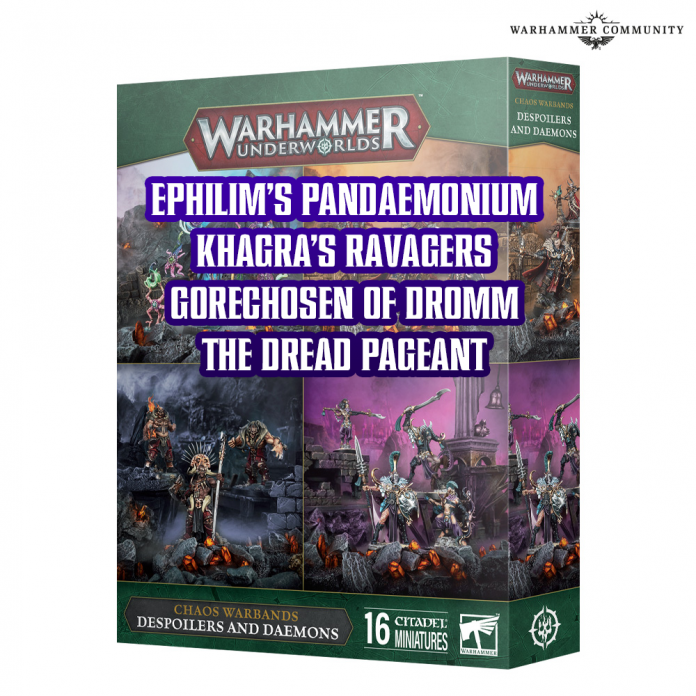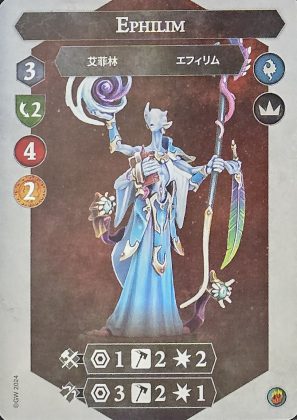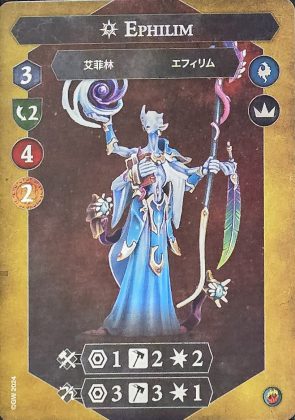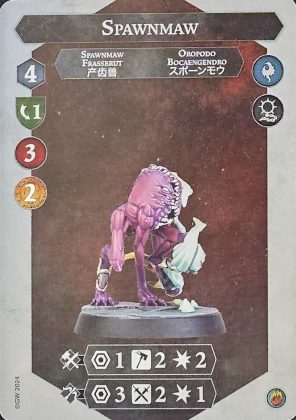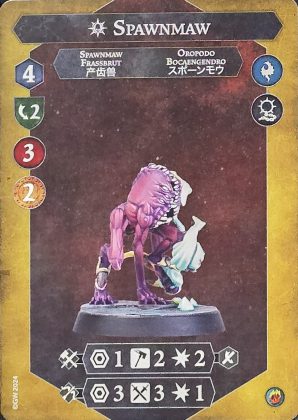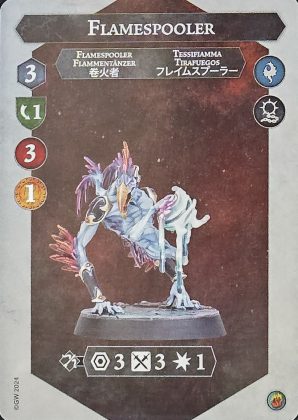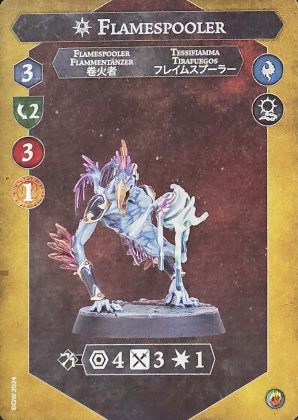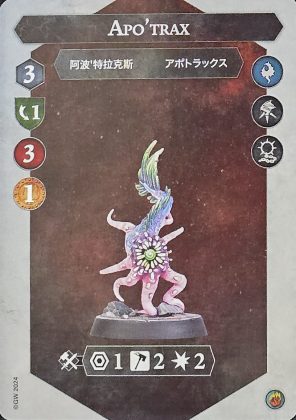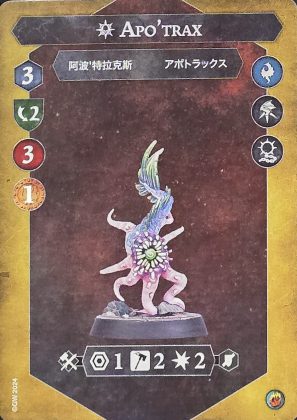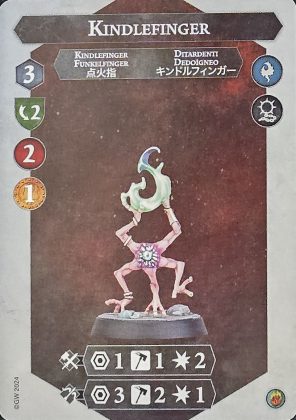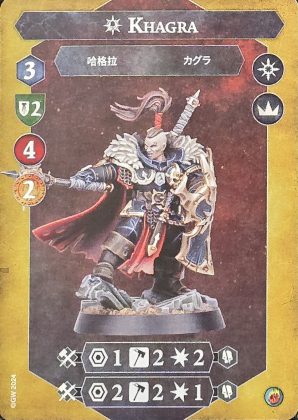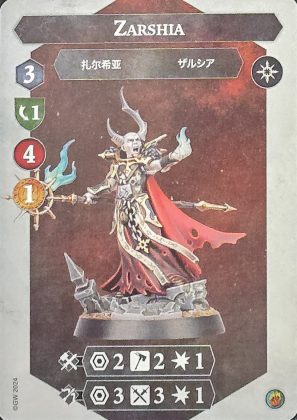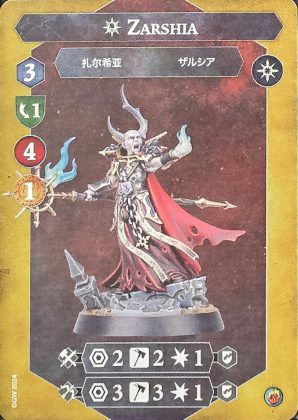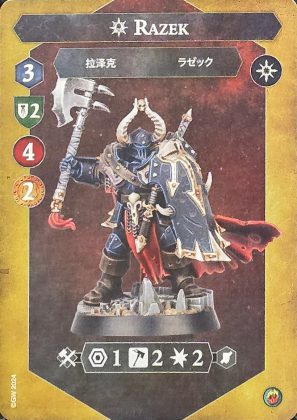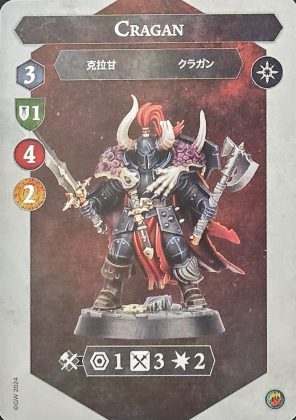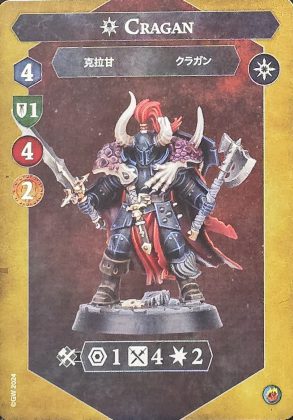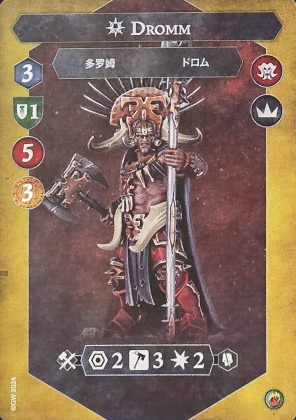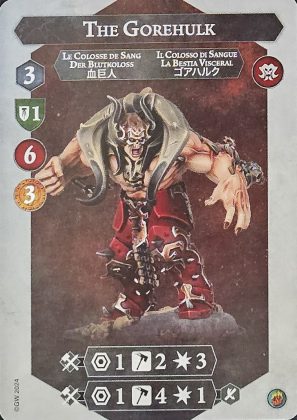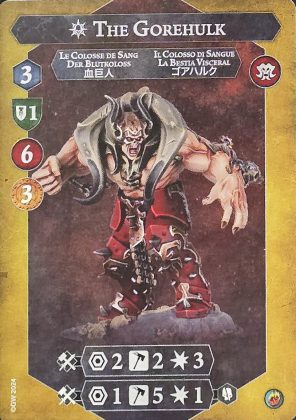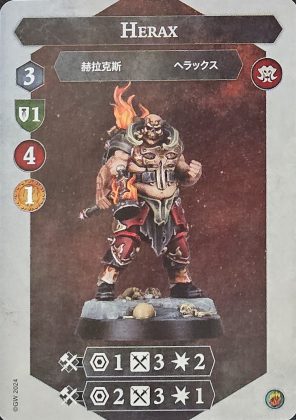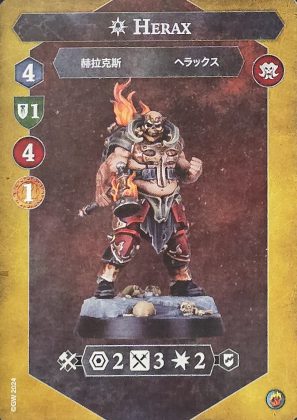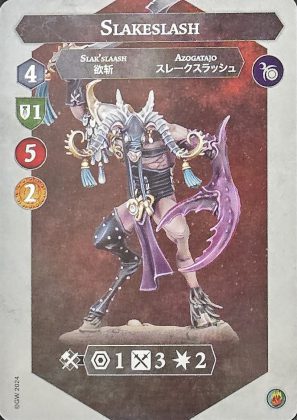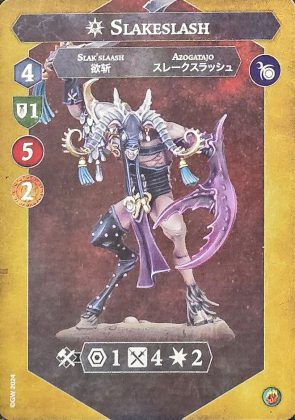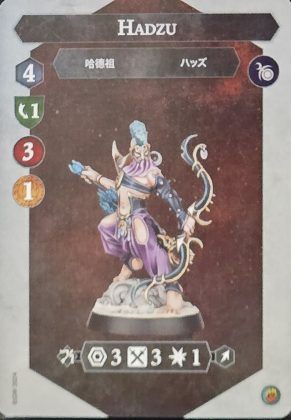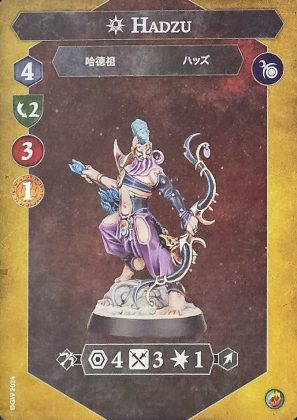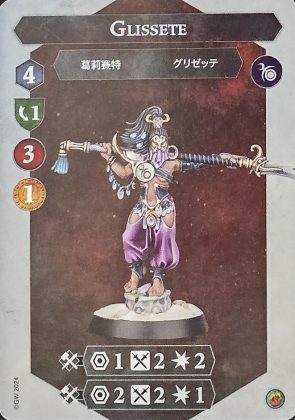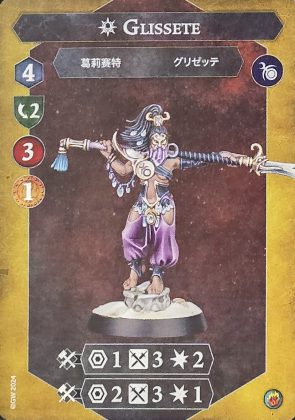It’s another Underworlds preorder day! That means Goonhammer has coverage for a deluge of Games Workshop releases that will be coming your way soon. It feels like we just did this recently, but that’s the new edition rush for you. There are four boxes, each containing four revamped warbands and themed to one of the Age of Sigmar Grand Alliances. We also have two brand new warbands in the Jaws of Itzl and Grandfather’s Gardeners as well as two brand new Rivals decks with Reckless Fury and Wrack & Ruin. That’s 18 warbands, 2 decks, and a lot of new rules to cover!
Before getting into the reviews, if you’re reading this on November 23-24, the World Championships of Warhammer are underway right now, and this year the Underworlds event has streamed coverage! Check it out over on the Mortal Realms YouTube channel. The hosts for the stream are Davy from the What The Hex?! podcast and Mike (aka Fishmode) from the Spent Glory blog and Underworlds Underground podcast. These two are genuinely wonderful dudes with a solid grasp on the game and a great way of explaining what’s going on. Check it out!
When covering the warbands, I’m going to take a look their fighter cards and accompanying warscrolls to go over what sets them apart compared to their contemporaries in the pool of 33 Organized Play legal warbands. If you want to check out the other items being covered today, you can find those articles here:
Revenants of the Realms: Death Warbands
Brutes and Bandits: Destruction Warbands
Heroes and Hunters: Order Warbands
The Jaws of Itzl and Grandfather’s Gardeners
Rivals Decks: Reckless Fury and Wrack & Ruin
Despoilers and Daemons: Chaos Warbands
Chaos is easily one of my favorite Grand Alliances. The models are frequently solid bangers where the sculptors can really go ham. Every single warband in this box was one I was eager to get my hands on and jam games with using these new rules. I haven’t been able to play with them all yet, but after familiarizing myself with their new rules I’m still mostly just as excited as I was beforehand.

Ephilim’s Pandaemonium made quite the splash when debuted in the previous edition – the warband’s faction deck was kind of bonkers and had to receive multiple nerfs to bring it back in line with the rest of what was out there. Let’s see if we’re off to a better start with this iteration that is, unsurprisingly, a Mastery warband.
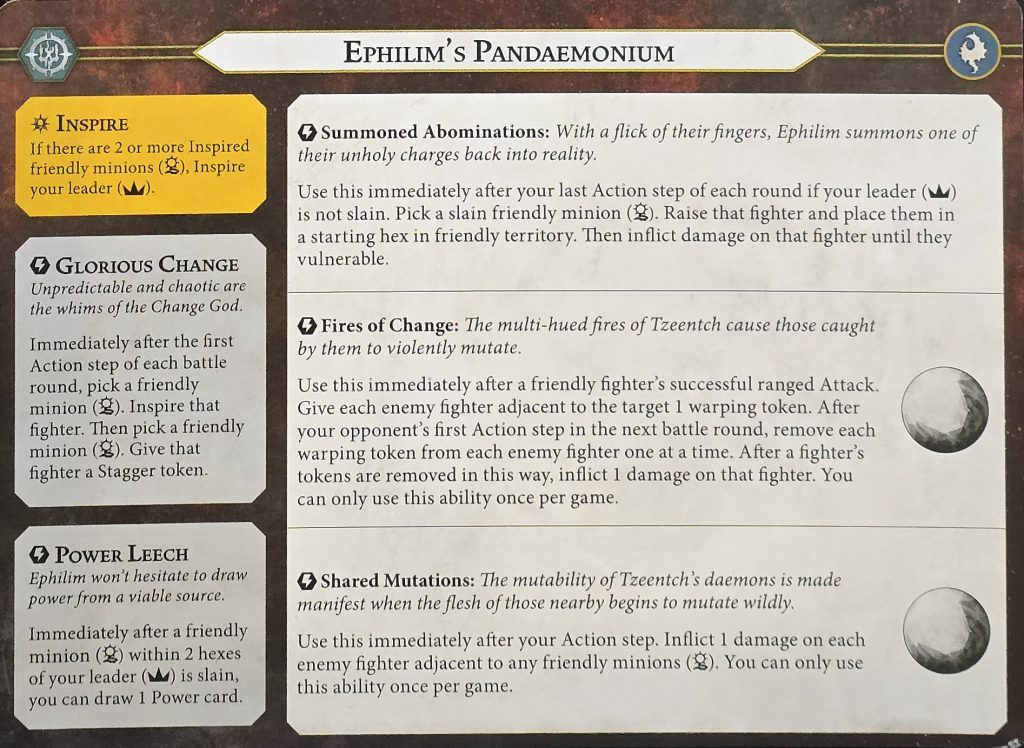
I like it when you look at the inspire mechanic on these warscrolls and go, “Huh?” In this case, the only fighter that will inspire based on this text box is Ephilim themselves. Let’s check the next box to see how the rest of the warband does it.
Glorious Change has you picking a minion (twice) after the first action step in each round. The first will inspire, the second will be staggered. Combined with the previous Ephilim inspiration requirement, this means at the earliest you’ll be inspiring Ephilim on round 2, and then only if your first fighter that you inspired is still around. There’s no clause here saying the second minion has to be different from the first, so if you want to you could always inspire one of them and then stagger it – in fact, if you’re down to a single minion that’s what you’ll be forced to do.
Speaking of losing minions, Power Leech allows Ephilim to siphon off a slain minion’s power and recycle it into a power card for your hand. The caveat is that Ephilim is going to have to be close enough to the minion to get that juice, so manage your positioning carefully.
Ephilim would be sad if all their little buddies wound up getting killed, even if they got turned into cards for you. Luckily, Summoned Abominations allows you to yank one of those slain daemons back from the Realm of Chaos and onto a starting hex in your territory. The downside is this minion is going to be coming back vulnerable and uninspired, but at least they’re not worth bounty if they die again!
Fires of Change is the first once per game ability on offer. You’re effectively giving one of your ranged fighters a sort of splashing, delayed bit of damage. If you’re ever up against an opposing warband that needs to clump up, either for scoring or for boosting their accuracy through flanked/surrounded, this can get a lot of bang for your buck. It only works with ranged attacks, so Apo’trax is the only fighter who can’t trigger it, but the timing is also after a successful ranged attack so you’re never going to waste it on a shot that winds up missing.
Shared Mutations is the final ability for the Pandaemonium and it’s another one with the potential to affect multiple enemies. Jamming one of your minions into a clump of enemies and blasting everyone adjacent for a damage is very strong, especially considering it has no restriction to non-vulnerable fighters and requires zero dice rolling. Even the timing on this ability – after your action step – means you get to position your minion where you want and fire this off before your opponent can respond with anything in the power step.
These models are so cool. I love how weird they look. I can imagine that these snapshots are just a brief glimpse at how any of these weirdos would appear and that if they were able to be animated, they’d constantly be shifting into all kinds of bizarre states.
The warband as a whole is sitting on slightly above average movement. Spawnmaw and inspired Kindlefinger are going to be your most maneuverable fighters, with special consideration given to Apo’trax due to their ability to fly. Apo’trax in particular has potential to be a good Shared Mutations delivery vessel if your opponent is trying to block you from getting to a key fighter.
Defensively, this isn’t the most resilient warband out there but that’s probably not surprising. Ephilim has the most health of the group, and even then it’s only 4. Kindlefinger, the littlest weirdo, has the least and the rest sit at 3. Saves across the board are at best “okay” and at worst they’re literally the worst save value you can have in the game at 1 dodge. At least when they inspire, everyone goes up to 2 dodge equally – I still consider 2 dodge to be a save value that’s always going to welcome easy access to guard tokens.
Looking at the weapon profiles, Ephilim’s already starting out ahead of the curve. What I’ve started considering to be the “average leader weapon” of R1/H2/D2 and R2/H2/D1 has a bit of an upgrade here – the close range is the same, but the reach version jumps all the way up to 3 range. Helpful for being able to hang back a little further, project threat a little more, and trigger Fires of Change. Ephilim on the whole doesn’t gain much when inspired – only a single attack dice on their ranged attack. That means if your opponent is really gunning for your inspired minions to prevent Ephilim from flipping, you’re not going to miss out on a whole lot.
Spawnmaw and Kindlefinger are your other two hybrid fighters, both sporting melee and ranged attacks. Spawnmaw is weighted more heavily toward the melee side of things while Kindlefinger is the opposite. Spawnmaw does gain ensnare on their melee when inspired, so if you’re up against an enemy warband that’s very reliant on dodge (like a mirror match or the Thorns of the Briar Queen), they could be your first inspire choice for the extra accuracy and improved defense. Kindlefinger isn’t likely to be your first inspire choice in many games, but at least their ranged attack does wind up jumping to a 4 hex range.
Flamespooler is the only fighter in this warband which doesn’t possess a melee attack. As a ranged only fighter, I was kind of hoping for more accuracy than three swords but beggars can’t be choosers. At least the range of the attack goes up to 4 when inspired, and Flamespooler also picks up an extra dodge which makes this another potential choice for the first inspiration of the game if you need to get an extra hex worth of reach on a target while standing on a treasure token, for instance.
The final fighter is Apo’trax, which is also the only fighter in this warband that has zero ranged capability. This starefish isn’t as fast as some of the other minions, but it does have fly. When inspired, it picks up cleave on a fairly average melee attack, but this is worth keeping in mind if your opponent is a shield heavy warband – and since there are twice as many shields on a dice than there are dodges, this will help punch attacks through more reliably than ensnare would on dodge fighters.
Wrack and Ruin feels like a potentially useful shell to use with these fighters. You’re augmenting the deck’s desire to inflict damage with Fires of Change and Shared Mutations, and the fact that most of the warband has ranged attacks makes the positioning based objectives more likely to score – plus the opponent is already going to want to spread out to minimize the impact of your warscroll’s ping abilities.Pairing it with Pillage and Plunder or even Blazing Assault for the positional tools and some extra oomph sounds tempting.

The Slaves to Darkness aesthetic has always been appealing to me, ever since I was a kid and picked up the old Realm of Chaos WHFB book with that cool horned skull on the cover. Khagra’s Ravagers used to suffer from being “kind of a hold warband but not really” and having some identity issues. Did Games Workshop revamp these four into a more cohesive Take and Hold warband? I think so!
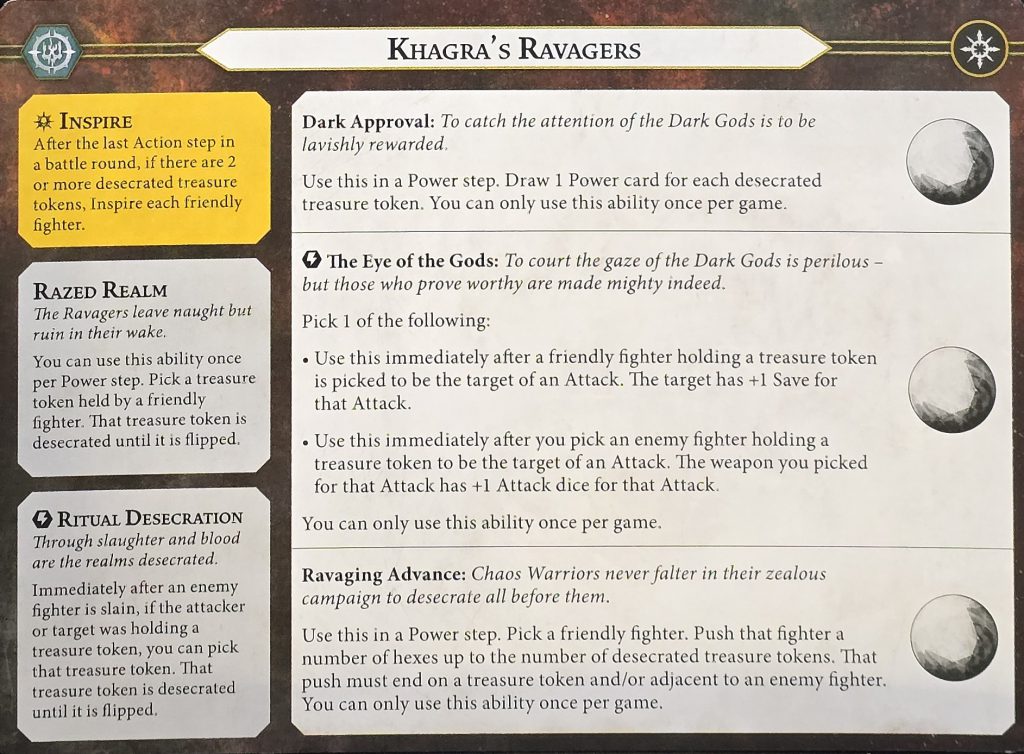
Straight away, we’re seeing mention of desecration and treasure tokens, so these fighters are still going to want to grab those treasure tokens and make them eeeevil. The target of 2 feels like a reasonable ask, and it shouldn’t be uncommon for this warband to go into the second round inspired.
Razed Realm and Ritual Desecration are two methods to go about this desecration process. The former is a sort of pseudo-delve mechanic that this warband has, which immediately puts them at odds with delving itself. You can only use Razed Realm on treasure tokens (not cover tokens) and the desecration status is removed whenever it’s flipped. Ritual Desecration gives you a more active way of approaching this desecration business and feels on brand with the warriors of Chaos – go kill stuff. If you or your target was on the treasure token, you’re good to go. This is most likely to be used when attacking enemies who are trying to block you by standing on treasures themselves, since otherwise you could just use Razed Realm in the power step.
What kind of payoffs are there for all this desecrating? First up is Dark Approval. In theory, this is a “draw 5 power cards” ability but I don’t think this will ever happen unless your opponent falls asleep at the table. In practice, getting to draw 1-2 cards is what I’d expect with the occasional 3 from time to time. Free cards are still free cards, and this is a great warscroll ability. In addition, they have Ravaging Advance that turns the desecration value into a positioning tool. Again, a theoretical cap of 5 is nuts but the more realistic push 1, 2, or 3 is still something I’d love to have regular access to. The restriction of having to land on a treasure token or next to an enemy isn’t too harsh – those are the places these fighters want to be, anyway!
The final warscroll ability here is The Eye of the Gods. Following the trend of the others, it’s a generically useful ability that is going to come up in every single game. You’re either going to have a situation where you really want to protect against an incoming attack or just punch through more reliably (perhaps for a Ritual Desecration).
The warscroll is a solid all-rounder. None of these abilities require niche circumstances. The main decision will be when you use them, because throughout the course of the game you will have plenty of opportunities.
The Ravagers aren’t quite on Stormcast level, but then again there aren’t Stormcast warbands with four (real) fighters, so they have the numbers game down at least.
There’s a lot of change happening here between uninspired and inspired profiles, so it’s difficult to paint with a wide brush but in general, your fighters are of average speed (3), decent health (4), and most of them have a save that’s average to good. All of the fighters gain a fair bit from inspiring, so you’re really going to want to chase down those desecration opportunities.
Khagra herself goes from an average fighter with 1 block and a serviceable melee attack to a sturdy 2 block with R1/H2/D2 grievous and R2/H2/D1 grievous options. She’ll serve well holding treasure tokens and threatening any who get too close.
Her sister Zarshia is in many ways the odd one out of this bunch. She’s only on 1 dodge, even inspired, so she is not going to do as well up close in the brawls. It’s convenient that she also has the only ranged threat in the warband, so having her on the back line offering support with her blasts (which have stagger when inspired) could assist in pushing forward onto occupied treasure tokens. If your opponent has fighters which can seriously threaten your warriors in the first turn or two of the game, Zarshia might wind up being on the front lines to serve as bait. If your opponent’s fighters aren’t as potent, she could hide behind the walls of armor instead. Zarshia does also offer a way to take out fighters standing on treasure tokens from a distance and trigger Ritual Desecration that way.
Razek and Cragan fill similar roles to Khagra herself, but in different ways. Razek’s profile is a clone in every way, except he doesn’t pick up extra reach when inspired. Instead, his axe sports cleave which is a handy accuracy boost. Cragan decides shields are for dorks and thinks having two weapons is better, so instead of picking up an extra save dice he’s sporting 4 move when inspired. It’s also worth noting that the four sword attack is going to have the best chance at triggering an Overrun if you’re trying to steal treasure tokens from your opponents, provided you can get the attack to land. A little help with flanking or rerolls would go a long way.
There’s strong synergy with Emberstone Sentinels, the only Take and Hold deck currently available so I have to imagine most builds with this warband will leverage it in some way. Blazing Assault offers plenty of tools to help you get your fighters to the treasure tokens they so crave, and also helps you punch through anyone foolish enough to stand in your way. Countdown to Cataclysm offers a few treasure-based objectives that would also fit in well. After seeing Zack Newcome play this warband at Worlds with Emberstone Sentinels and Pillage & Plunder, I’m even sold on that combination – despite being ostensibly a delve based deck, Pillage & Plunder has enough non-delve objectives and power cards to assist this warband with its gameplan.

Okay, let’s talk about the elephant in the room. As I am putting the final touches on this article, the World Championship of Warhammer is underway. There were 46 participants who made it to the event and of that number, 17 brought Dromm. There are a variety of reasons for this – in an unexplored meta or game, the straightforward “go aggro” approach is often a safe on to rely on. It’s also less of a brain drain than some more complex warbands like Ylthari’s Guardians or Brotherhood of the Bolt, and that’s important when you’re playing games for four days straight against the literal best players in the world. Also, of the six decks available, there are two Strike decks that both slot very well into the previously mentioned ABC (Always Be Charging) strategy, so this approach has a deeper pool of cards than others might. Finally, the stats on these fighters are kind of bananas. Oh, so is the warscroll. To no one’s surprise, these guys are a Strike playstyle.
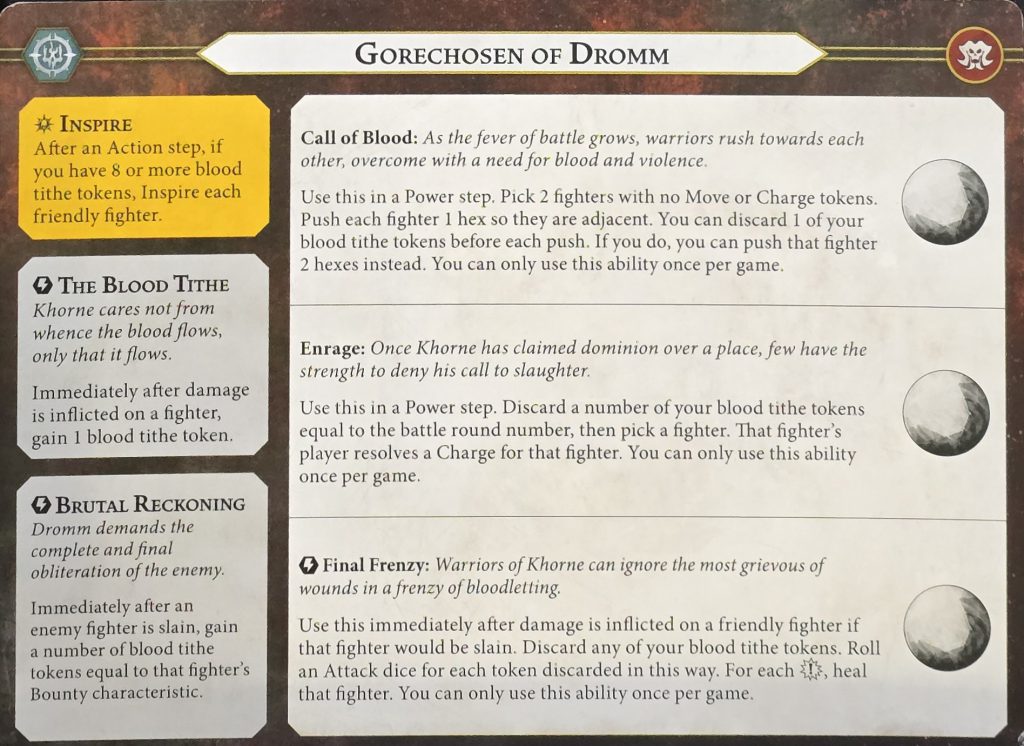
Blood tithe tokens are the name of the game here, and as always Khorne’s number of the day is 8. Once you get 8, you’ll inspire everyone and unlock True Punching Power.
The Blood Tithe is the first mechanic that generates the tithe counters themselves. Not very creatively named, but I guess Khorne is a straightforward god. The phrasing here is important – “a fighter” means either your fighters or your opponents will generate blood tithe for you. Also, it’s whenever damage is inflicted, not just from attacks. This means ploys that deal damage, or upgrades that deal damage, or even the other warband using their own abilities that damage their own fighters (such as Ephilim’s Summoned Abominations or the Sepulchral Guard’s Arise!). It also means that if your opponent is counting on doing lots of small amounts of damage to you, they’re going to feed the tithe quickly.
The other way of generated blood tithe is through Brutal Reckoning, which provides a nice chunk of them in a burst when an enemy is slain. There’s less nuance here. Kill fighters, gain blood tithe.
What can you do with all this blood tithe aside from inspiring? First up is Call of Blood which is incredibly flexible. You push two fighters to be adjacent to each other, and if you have enough blood tithe tokens they can be up to 4 hexes apart. Pulling enemies off of treasure tokens, creating a mosh pit for the Gorehulk to dive into, or setting up charges deeper into enemy lines are all options.
Enrage is a doozy and one of the swingiest abilities we’ve seen in the game. It’s conceivable to take your first turn and charge with a fighter, gain a blood tithe, then spend it on Enrage in your power step to get another charge with the same fighter before your opponent ever has a turn or even a chance to act in the power step. I’m sure this isn’t a surprise, but getting two attacks off in a row with this warband can hurt. You do have the option to target any fighter, so if you really want to you could make the Sepulchral Warden charge (provided someone is within his very short charge range) and shut off Forward! and Arise! for the remainder of the round. Or, you know, just charge him and pulp him.
Final Frenzy is the last ability, and it’s what you’re going to be using all those banked blood tithe tokens for once you get past the very few you’re going to spend on the other abilities. 16% chance per dice to heal isn’t great, but by the time you have taken enough hits to actually lose a fighter, you’re going to have a handful of blood tithe tokens sitting around with no other use. All you need is to roll enough to bring your fighter back to vulnerable and they’re good to go. Anything else is just extra, and the idea that you could theoretically full heal after being slain is terrifying, so it’s good that it’s statistically unlikely. Still, there genuinely is no other use for blood tithe tokens once you’ve inspired and used the other two abilities, so why not dump 15+ dice into healing your Gorehulk?
3/3/1 is a bizarre bounty split for these guys. If you compare Herax to most other 1 bounty fighters it’s hilariously lopsided in his favor.
You’ll find average movement of 3 on these brawlers, with only Herax inspiring to 4. Saves are fine, with 1 shield being serviceable and benefits well from any upgrades that give extra save dice. The health total on this warband is equal to most of the Stormcast bands out there, but the Gorehulk gets 6 of it while Herax, poor little bitty Herax, has 4.
This is a Khorne warband and they’re not going to disappoint when it comes to weapon profiles, so hold your nose because we’re going in. Dromm has that average “leader weapon” profile but the inspired version really jumps up in value – being able to reliably land 3 damage hits from 2 hexes away is substantial. The Gorehulk is a truly terrifying fighter with an impressively flexible pair of options for attacking anything next to him. There’s the high damage, less accurate attack or the lower damage, highly accurate attack. The former is always going to be tempting, but the latter is a very reliable blood tithe generator. Inspired, the Gorehulk gains extra stretchy arms for some reason for the big damage attack and the extra reliable one jumps to a wild 5 dice on hammers with grievous. That’s an insane degree of accuracy on a 2 damage attack, which is going to just instantly gib a lot of the minion level models in warbands.
Then we get to Herax, who doesn’t really compare to the two others in the warband, but that’s unreasonable to ask. He’s the ultimate sacrificial lamb that can go up front and bait the opponent in. If he gets attacked, that’s fine. You’re generating blood tithe from it and he’s probably going to survive with his 4 health and 1 shield. His weapon profile is a slight twist to the standard “leader weapon” profile which says a lot, and when he inspires they likewise merge into a stagger delivering punch from 2 hexes away.
Even with just two days of games at Worlds so far, there’s a lot of talk about how this warband might need a nerf based on their stats and the prevalence of players who brought them into the blind meta. They’re definitely strong, but are they meta warping strong? Are they going to win Worlds after all? Interestingly, I think the Grandfather’s Gardeners are situated to be an especially strong counter to this warband and their absence from the available pool for Worlds players might have something to do with how many Dromms showed up.

The original Slaaneshi warband is back and ready to roll as a Flex warband. These mortal followers of the god of excess certainly rock some flamboyant outfits, but do their rules match their drip?
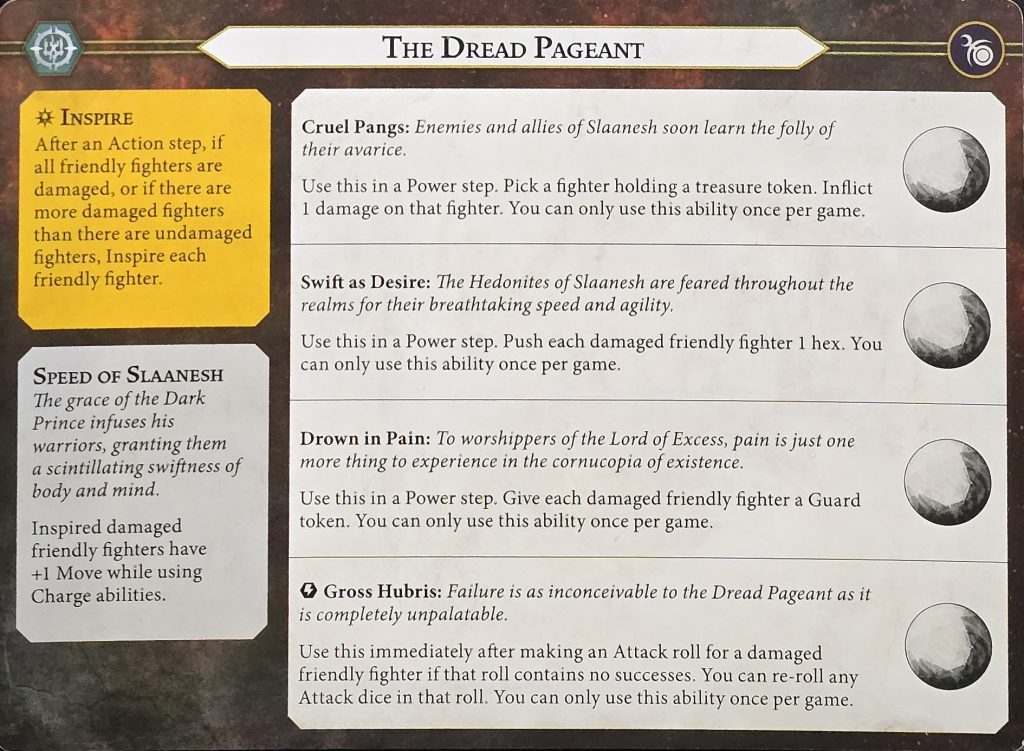
The inspiration mechanic for the Dread Pageant does a great job of highlighting the major theme of this warband. Multiple of their warscroll abilities only work on your damaged fighters, and spreading out damage amongst themselves (and with the enemy!) is what they’re going to aim to do.
Speed of Slaanesh is the first of those incentives for being damaged – if one of your fighters is both damaged and inspired, they’ll gain the benefit here. The warband as a whole is already above average in speed, so this lets them really slam into overdrive.
Cruel Pangs will let you poke any fighters holding a treasure token for 1 damage. You can either use this on your own fighters to help trigger inspiration and turn on other abilities, or if your opponent is trying to go for a treasure token based strategy this can be used to punish them. It does only work on treasure tokens, so fighters who delve the treasure away won’t be eligible targets. I like to point out when pings don’t have vulnerable restrictions, and this is one of them – so feel free to use it to finish off a fighter with only 1 health remaining.
Getting into some more benefits for having damaged fighters, Swift as Desire increases the already solid maneuverability of your warband. Being able to push up to 4 fighters at once is quite the ceiling for this, but even getting to position one or two in key locations can swing the game in your favor so don’t sit on it waiting for the perfect moment. That’s some very anti-Slaanesh sounding advice, in hindsight.
Drown in Pain can help keep your damaged fighters from going down and also help you hold treasure tokens easier – it’s also great synergy with Hadzu and Glissete once they inspire, making them much harder to injure.
The final Dread Pageant ability is Gross Hubris. It’s a straightforward “try again” for one of your failed attacks, but only if the roll contains no successes. When it comes in handy, you’ll appreciate it, but most of your fighters are rolling 3 or more dice for their attacks, so it’s not going to be as reliable as I might hope.
The bounty split here is 3/2/1/1, with Vasillac rocking the highest, followed by the always bizarre Slakeslash.
They’re a speedy bunch, sitting at 4 move base (before adding in any from Speed of Slaanesh). Save values are average to low, with Hadzu and Glissete both upgrading from 1 dodge to 2 dodge when inspired. Slakeslash and Vasillac have the highest health pools, which combined with their better save values makes them the most durable of the fighters. Hadzu and Glissete are going to need some support to survive longer since they both only have 3.
Vasillac rocks the “leader spear” profile (R1/H2/D2 and R2/H2/D1) but it receives a nice glow up when inspired to fairly reliably dish out 3 damage from 2 hexes away. Slakeslash’s profile starts out “fine” and barely upgrades, but the warband’s pushes and move speed means you should ideally be able to get some flank/surrounded assistance on their rolls. Hadzu’s not going to be dishing out much damage, and it’s going to be less accurate than I’d like, but having grapple on a range 3 (or 4!) attack is really cool. Glissete must have shopped as the bargain outlet because her off-brand leader spear is just a less accurate impression that only gets slightly better after inspiring.
Given their average defense values and the warband’s desire to get injured, I was hoping for some more impactful weapon profiles. I’m also still a little sad to see Glissete lost the “always on guard” rule which was a cool and unique thing she did. I’ll still give these four a spin, but they’re not looking like as solid of a pick as the others in this box.
For deck pairings, it feels like Wrack and Ruin is tailor made for these Slaanesh followers. That deck rewards spreading out damage and having your own fighters injured, which is precisely what these four want to do anyway. They’re flexible enough that I feel any approach could work, but I’d probably lean toward a more aggressive one than a “stand on treasure tokens” one because they’re not the most durable to begin with.
That’s it for the Chaos warbands released in Despoilers and Daemons. Check out the rest of Goonhammer’s coverage if you want to see what else is in this massive drop of Underworlds content!
Revenants of the Realms: Death Warbands
Brutes and Bandits: Destruction Warbands
Heroes and Hunters: Order Warbands
The Jaws of Itzl and Grandfather’s Gardeners
Rivals Decks: Reckless Fury and Wrack & Ruin
Have any questions or feedback? Drop us a note in the comments below or email us at contact@goonhammer.com. Want articles like this linked in your inbox every Monday morning? Sign up for our newsletter. And don’t forget that you can support us on Patreon for backer rewards like early video content, Administratum access, an ad-free experience on our website and more.
